Deep Dive
If you’re starting a newsletter and want to get your first 1,000 subscribers fast, this guide is for you.
We’ll cover everything you need to know in ~20 simple steps — from your newsletter idea, value proposition, growth tactics to 1,000 engaged subscribers, to your first dollar online, and more.
Let’s get into it!
A newsletter — at its core — helps the reader solve a problem.
Step one of starting your newsletter is to develop your newsletter’s value proposition — how your content solves a problem and helps the reader.
To do this, we’ll use the “Job’s To Be Done” framework.
Here’s what this means…
You can bucket every great newsletter into the “job” it’s doing for people.
For example:
Help me save money on flights: Going
Help me become a better dad: Daily Dad
Help me build better habits: James Clear
Make me smarter about crypto: Milk Road
Keep me informed with just the facts: 1440
Help me expand my vocabulary: Word Daily
Inspire me and help me be positive: Nice News
Keep me up to date on tech in 5 minutes: TDLR
Help me sell more sponsorships: Creator Wizard
Help me get a job on Wall Street: Wall Street Oasis
Help me win more at fantasy football: Football guys
Help me use AI to become productive: Superhuman
My newsletter’s job-to-be-done is to help you grow and monetize your newsletter. To share news, insights, and tactics on how you can do that.
If I can do this job for you, consistently, you’ll keep reading.
When starting a newsletter your goal should be to find one “job to be done” that you can do better than anyone else in the world.
You don’t need to be the best in the world right now. But strive to be.
Find your “Job To Be Done” by answering 2 questions:
Who exactly are you writing for? Think of a specific person. What would they find extremely useful or interesting?
What is the concrete job you’re doing for them? Be specific. How exactly will you help them fulfill their desires, reach their goals, and solve their problems?
A few tips to better answer these questions:
Think about one person.
Seriously, just one.
That could be a friend, client, employee, reader you know, or even your past self.
It makes the content you’ll create personal. Personal content helps you solve that person’s specific problem.
What is most personal is most universal.
The problems that person has are likely problems most of your subscribers will have too.
Don’t be vague.
Your job to be done should be specific, tangible, and concrete.
That job should be something people would pay for (even though your newsletter will be free).
If your job to be done is:
Help me become smarter
Make me happier
Entertain me
Inform me
It’s too vague!
Think about how you’ve helped people in real life — like with your work or in your personal life.
Is there something you can do better than anyone else?
Or is there something you’re obsessed with more than anyone else?
For most folks, that “thing”, that “job” will be small.
That’s okay! Think small. Think narrow. Think niche.
You can expand or broaden your job later. Getting your first 1000 subscribers is about showing how you can serve 1000 people.
If your job to be done can only help 1000 people in the world who have a specific problem or interest, that’s good!
Help those people better than anyone else. Then expand later.
2) Pick a Niche, Then Go 2 Levels Deeper
“Become the best in the world at what you do. Keep redefining what you do until this is true.”
By narrowing down who your content is for, you stand out more.
Most newsletters fail because they try to be everything to everyone. Inevitably, they end up nothing to no one.
There are so many newsletters about “business”, “tech”, “sports”, “politics”, “fitness”, "health", etc.
Your newsletter will likely fall into one of these categories. But it needs to be at least 2 niches “deeper” to stand out!
For example:
Fitness → Bodybuilding → How to bodybuild on a keto diet
Tech → AI → AI for marketing → How to use generative AI to make ad creative
Local news → Things to do in your city → Restaurants and food in your city
Business → Media companies → Newsletter-first media companies → How to get newsletter subscribers
After niching down 2-4 more levels you can find a topic you’re a world-class expert in.
If you’re not an expert yet, that’s ok. Pick a niche you're obsessed with. Something you could see yourself writing about for 10 years.
Over time, you will become an expert and your content will improve.
The next thing to decide is what kind of newsletter you want to write.
There are 4 main types:
1) The Analyst — Deep research and analysis of an industry or topic
Examples:
Stratechery — Analysis of the strategy and business side of tech
The Generalist — Insights and analysis on the most important companies in tech
A Media Operator — Analysis of strategies that go into building digital media companies
Sinocism — News and analysis of China
Van Trump Report — Insights and analysis Agriculture professionals and investors
Chartr — Data-driven insights into business, tech, and entertainment with infographics
2) The Curator - Summaries, key takeaways, and trusted and relevant creations like links, articles, tools, resources, advice
Examples:
TLDR Newsletter - Summaries of the most interesting stories in startups, tech, and programming
Exec Sum — curated news and links for bankers and investors
Ben’s Bites — Curated AI news and product launches
The Browser — 5 curated stories in your inbox each day
Tim Ferriss’ 5 Bullet Friday — 5 things Tim loves, uses, reads: Books, gadgets, hacks, and more.
James Clear’s 3-2-1 Newsletter — 3 short ideas from James, 2 quotes from others, and 1 question for you to ponder
5 Tweet Tuesday — 5 curated tweets from Shaan Puri
Word Daily — A new word every day
3. The Expert — Deep knowledge of a specific topic, “how to” content, and advice
Examples:
Marketing Examined — How to become a better marketer
Lenny’s Newsletter — A weekly advice column about building product, driving growth, and accelerating your career
Houck’s Newsletter — tactical advice to build, grow, and raise capital for your startup
Justin Welsh — How to build a one-person online business
World Builders — The newsletter to make you a smarter storyteller
4. The Reporter — News, stories, and updates on a topic, niche, or industry
Examples:
Morning Brew — Daily news on business and finance
The Hustle — News on business and tech
The Dispatch — Reporting & commentary on politics & culture, informed by conservative principles.
Popular Information — Independent accountability journalism
Milk Road — Funny crypto news
The Neuron — AI news and trends
I encourage you to read this article from Inbox Collective that goes deeper into the 4 types of newsletters.
Most newsletters are a hybrid of 2 types. Often that means primarily being an Analyst, Expert, or Reporter — and offering some curation too.
Your newsletter is its own media property.
Give it a separate name and domain. But don’t spend too long mulling over it.
Examples:
Shane Parrish: Brain Food
Ben Meer: System Sunday
Tim Ferriss: 5-Bullet Friday
Michael Houck: Houck News
James Clear: The 3-2-1 Newsletter
Justin Welsh: Saturday Solopreneur
Sahil Bloom: The Curiosity Chronicle
5) Chose a Sending Schedule
Commit to a consistent cadence, and make sure it’s sustainable
I recommend you start with a weekly newsletter — send your newsletter on the same day and time each week.
More often can create burnout. Less often is not enough to keep readers engaged.
The day of the week you send doesn’t make much. Pick the best day for your writing schedule.
Over time, you can send more. 2, 3, or 5 times a week.
But only increase sending frequency after you find ways to consistently grow and monetize your newsletter.
6) Create a Content Template
Create a short and simple content format/template that’s easy to repeat.
You don’t want to be writing from scratch every week. Your content should fall into a simple and repeatable template that makes it easy to write and research.
Also, this format will give readers a consistent experience so they will build the habit of opening and reading your newsletters.
Readers should always know what to expect.
Here are some of my favorite examples:
The Big Idea - The biggest news story of the day
Snippets - One line summaries and links
Chart - Infographic and story
Around The Web - Cool curated stories and resources
3 Ideas
2 Quotes
1 Question
5 things Tim has loved, used, or read: Books, gadgets, hacks, and more
Check out these newsletters for more great examples:
1440
Chartr
Exec Sum
Ben’s Bites
Creator Wizard
Stacked Marketer
Marketing Examples
The Curiosity Chronicle
Then read this post on the 10 best newsletter types and formats for more.
Don’t be married to your template. You’ll improve it over time.
7) Pick and Set Up Your ESP (Email Service Provider)
2 years ago I could write 2,000+ words about this.
Now my answer is: beehiiv
Beehiiv simplifies the process and replaces 5+ tools. beehiiv makes it easy to get started AND has your dedicated website.
Part 2: How To Get Your First 1,000 Newsletter Subscribers In 30 Days
Here’s how to get your first 100-200 subscribers before you send your first newsletter.
Pre-Launch Growth Tactics — Do This Before You Send Your First Newsletter
First, you’ll need a page to collect email addresses.
1) Create your landing page
Day: 1
Time needed: 30 minutes
Est subscribers added: 0
You must have a dedicated landing page for your newsletter. Don’t send people to a website or linktree.
Create a simple custom landing page with beehiiv. A good landing page will convert 50%+ of visitors into subscribers.
Your website or linktree distracts visitors with options and will convert 10%-30% of visits into subscribers.
Read my guide on how to make a great landing page here.
2) Add call-to-actions (CTA) everywhere you can
Day: 1
Time needed: 15 minutes
Est subscribers added: 10
Think about all the “digital real estate” you own. Website, email signature, social media accounts, slack profile, etc.
Add a CTA for your newsletter on all of it.
CTA on your website
CTA in your email signature
CTA in your social media bios
CTA in private community profiles
Don’t worry about making the CTA copy perfect. You’ll have time for that later. Just add them everywhere you can quickly.
And only add CTA for things you already have. If you don’t have a website that’s ok! You should have a newsletter landing page by now.
That’s all you need to get started.
3) Send an announcement text to friends and family
Day: 1
Time needed: 30 minutes
Est subscribers added: 10-30
To start a newsletter you need people to write to. The best way to do that is by asking friends and family to subscribe.
Every successful newsletter that interviewed that now has millions of subscribers started by asking friends and family to sign up.
Don’t skip this step.
It will hold you accountable to follow through and publish your newsletter.
Don’t be afraid to ask people to subscribe! If this pushes you out of your comfort zone that’s good.
To build a successful newsletter you’ll need to ask for a lot of things that make you uncomfortable. Do it.
Even if you don’t think your friends and family will be interested in your newsletter topic — still ask them to sign up.
You need traction. Right now every subscriber matters.
Sent a 1on1 text message to friends and family like this:
Hey <name>,
I started a newsletter <topic and name>.
<one sentence about how you help readers or what readers will learn>
If that sounds interesting, sign up here:
<link to landing page>
It goes out <number per week> and you can unsubscribe anytime.
Example:
Hey Mark,
I started a newsletter! It’s called Morning Brew and it’s about what’s happening in the business world.
The goal is to help readers become smarter about business and finance in just 5 minutes a day.
If that sounds interesting, sign up here:
MorningBrew.com
It goes out every weekday and you can unsubscribe anytime.
4) Announcement post on social media
Day: 1
Time needed: 30 minutes
Est subscribers added: 50-75
Create a simple announcement post about your newsletter and publish it to all the social media profiles you have.
Keep the announcement short and simple. This post should look a lot like the text message you just sent to friends and family.
Here are the key things to include:
Tell people you started a newsletter
The name of the newsletter
The topic of the newsletter
Who the newsletter is for
How it helps readers
What newsletter readers will learn
A CTA to sign up
Link to your landing page in the post or a reply to the post
Now here’s the important part of this step:
Don’t post this and hope people will see it and sign up.
Share this post with all the friends and family you just texted.
Ask those folks to like the post, comment, repost it with their account
If you get 10 people to do this (ideally more) your announcement post will reach way more people — and you’ll get more subscribers.
It’s easier to get friends and family to share a social post than to share the actual newsletter.
Ask people to share right after you post the announcement. Don’t wait.
This is one of the few opportunities you get to ask people to share something. Take advantage of it.
5) Post a newsletter teaser (Pre-CTA)
Day: 2
Time needed: 30 minutes
Est subscribers added: 50-100
About 24 hours before your first newsletter issue goes out, post a teaser about it on social.
Here’s the teaser I posted before my very first newsletter:
This got me my first ~150 subscribers.
This is called a “Pre-Newsletter Call To Action” aka “Pre-CTA”.
They’re simple to create and extremely effective and converting your social followers into subscribers.
With Pre-CTAs, you can create:
Fear of missing out (FOMO) on your content
Urgency to sign up and get access to the content
Curiosity to see what the newsletter content is about
To do this, simply write about what your newsletter covers and what subscribers will learn.
Post it 24 hours to 8 hours before the newsletter is published.
Here’s a list of 20+ Pre-CTA examples.
Post-Launch Growth Tactics — How To Go From 100 to 1,000 Subscribers
At this point, you’ve gotten ~50-200 subscribers and published your first newsletter issue.
Here are the growth tactics you’ll use to reach 1,000 subscribers and beyond.
6) Repurpose and distribute your content
Day: 3-30
Time needed: 30 minutes a day
Est subscribers added: 300+
“Create once. Distribute forever.”
Don’t make the mistake of creating content for your newsletter — then never sharing that content anywhere else.
Growing a newsletter is all about repurposing, distributing, and promoting your content across other channels (social media, your website, private communities, and more).
If people like that content, they’ll subscribe for more content in your newsletter.
Every newsletter issue you create should be repurposed into at least more 5 pieces of content.
For example:
You write 1 newsletter per week.
To repurpose that content for Twitter you create:
1 thread
4-6 tweets
…all from that 1 newsletter.
Then you repurpose that newsletter to LinkedIn and create:
1 carousel
4-6 images
The same can be done for Instagram and Facebook.
That’s 10+ social posts from 1 newsletter.
You can also repurpose and distribute that content to private communities, FB groups, slack groups, subreddits, and more.
Of course, your content needs to be customized. Don’t spam. Your repurposed content should look native to each platform you’re sharing it on.
7) Send an email to all of your contacts — friends, co-workers, followers, and connections
Day: 4
Time needed: 1 hour
Est subscribers added: 100+
Now that have a newsletter live you can reach out to people outside your friends and family about subscribing.
Step 1: Make a list of all your contacts:
Every contact in your phone
Everyone in your email address book
All your LinkedIn connections that have public email
If you run a business, all your clients and customers
(If possible) A list of all your past and current co-workers
Even if you don’t have a large network, this should be 200-500+ people.
Step 2: Write an email that tells them about your newsletter and why they should subscribe.
Here’s an example:
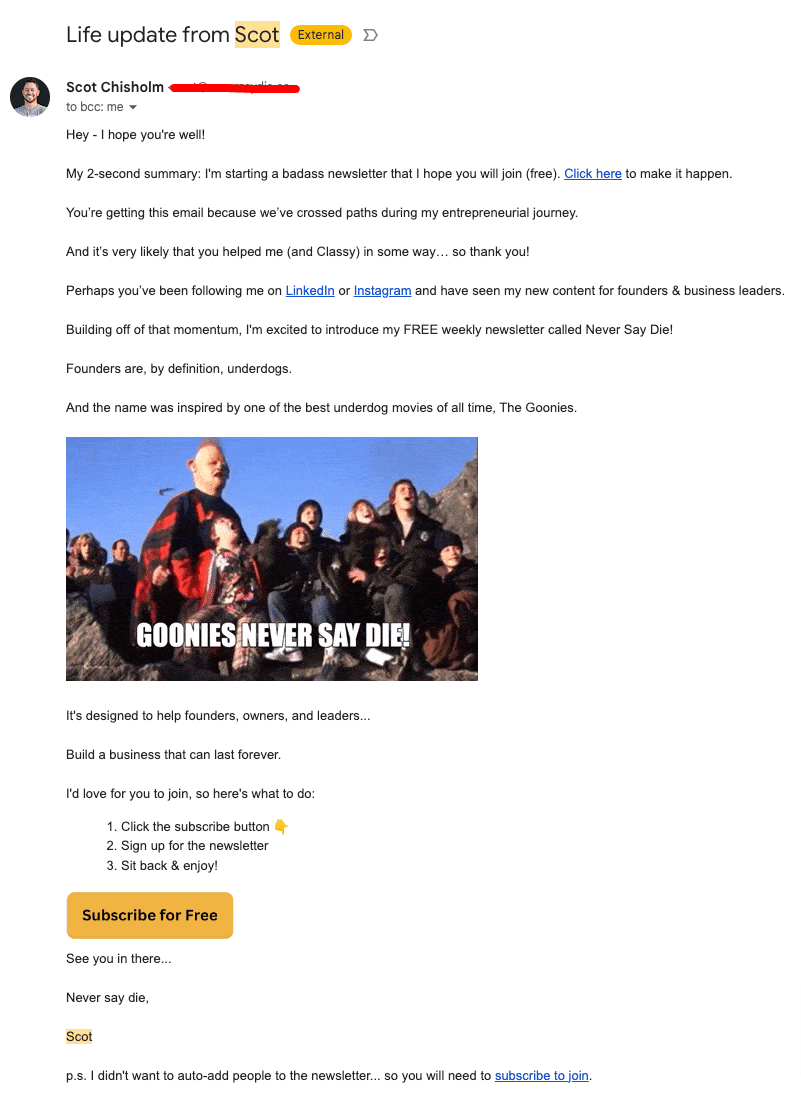
In this email, you need to:
Quicky tell people what this is about (your newsletter)
Tell them why they are getting this (you’ve crossed paths before)
How this will help them (your newsletter benefits and topic)
Do not auto-add people to the newsletter. Make sure this is clear in your email.
Add a link to your landing page where people can subscribe.
Step 3: Send this email to all your contacts
There are 2 ways to send this.
Send 1 email at a time and customize the name and first line
Send the email to everyone with Gmails BCC feature
Either way works.
You’ll get more sign-ups with the customized email, but it takes longer.
You can also set up cold email tools that automatically customize the first name for you. But those take time to set up too.
I’d recommend using BCC. It’s fast and easy.
You’ll only be seeing 2-3 emails to this list.
Step 4: 3-5 days later send a follow-up email to this list
Keep this email short and simple.
This should be a follow-up and reminder of what you sent before.
1-2 follow-up emails are all you need for this type of list.
After that move on to the next strategy…
8) Post daily on 1-2 social platforms and convert your followers into subscribers
Day: 4-30
Time needed: 30-60 minutes a day
Est subscribers added: 500+
This is where 70-80% or more of your first 1,000 subscribers will come from.
There’s no getting around it:
To grow a newsletter, you need to publish content on social.
If people like that content, they will subscribe to your newsletter for more content.
It’s that simple.
Newsletter content is rarely discovered or shared like social media content is. You must build an audience on social to grow your newsletter.
Here’s how to grow on social and convert those views and followers into newsletter subscribers:
Step 1: Pick 1-2 social platforms where your audience is.
It doesn’t matter which one as long as your ideal audience is there.
For most newsletters, it’s LinkedIn and Twitter.
The format of these translates well to newsletters. People who read text content for hours every day are likely to read newsletters.
Step 2: Pick a posting schedule you can stick to for 30 days.
At first, your focus should be posting consistently. Don’t worry about getting engagement on your posts, yet.
If you post consistently for 30+ days, your content will get better and you will get engagement (likes, retweets, shares, comments).
Make consistent posting easier by repurposing your newsletter content (as covered in item #6 above).
I recommend starting with 5 posts per week schedule — 1 post per weekday.
Step 3 - Include CTAs in (almost) all your social content
There are 5 types of call to action you should use:
A. Auto-plug after popular posts
After a post hits 10-20 likes you can use tools like Tweet Hunter or Taplio to automatically “plug” your newsletter:
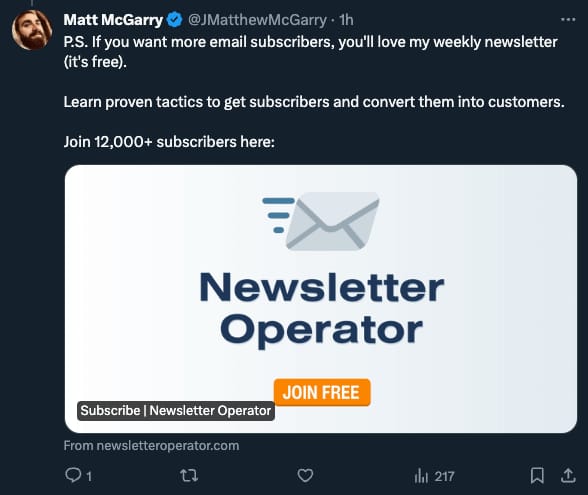
B. CTA at the end of long posts, threads, or carousels

C. CTA in your profile text and banner
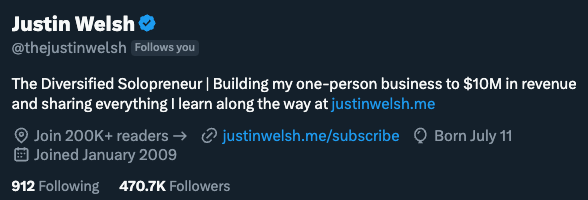
Justin Welsh, Twitter (X)

Dan Go, LinkedIn Banner
D. Pre-Newsletter CTA
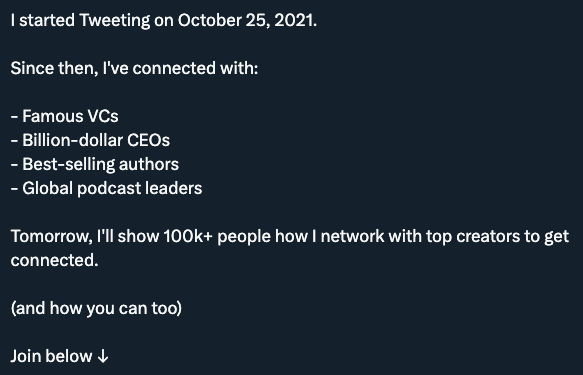
Justin Welsh, Twitter (X)
E. Post-Newsletter CTA
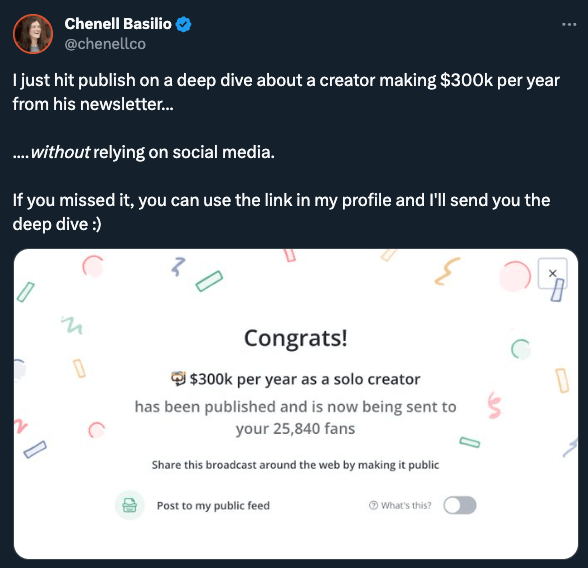
Tell people about your newsletter, after it was published.
For more on pre-newsletter and post-newsletter CTAs, read this guide. It includes 10+ examples of each.
9) DM all your new followers and connections
Day: 5-30
Time needed: 10 minutes a day
Est subscribers added: 100+
Now you should be posting daily and gaining new followers.
Tell them 1on1 about your newsletter with a DM or private message.
Sent your new followers a short and simple message like this:

Thank them for following
Tell them what your newsletter is about
Share a link to your landing page where they can sign up
Bonus points if you ask them how you can help.
Use these DMs to get more than just subscribers. The DMs are a place to build relationships, get reader feedback, and find clients/customers.
10) Build real relationships
Day: 1-30
Time needed: 15 minutes a day
Est subscribers added: ~
When you’re building your newsletter, don’t forget it isn’t just an “email list.”
There are real people behind those email addresses. Real people that can become your friends, customers, mentors, and supporters.
Take the time to build 1on1 relationships with the people on your email list.
When you build those relationships, they lead to:
Your content getting shared
Business opportunities
Podcast interviews
Cross-promotions
Introductions
Referrals
& more
When you’re just getting started, respond to everyone who replies to your newsletter, comments on your social posts, DMs you, etc.
Don’t go into the conversation with an objective. Be helpful for free.
Later on, these relationships will lead to revenue and opportunities.
Then reach out to people you want to connect with:
Leave thoughtful comments on 10 other posts in your niche every day
Reply to your favorite newsletters. Tell them you liked the issue or share helpful feedback.
Respond to polls and surveys from your favorite creators
Send cold emails or DM to creators you can help or collaborate with
Most of these outbound actions won’t lead to anything immediately.
But if you keep creating helpful content and engaging with others in your niche/ industry, people will notice.
11) Join a community
Day: 1-30
Time needed: 15 minutes a day
Est subscribers added: ~
Join multiple communities in your niche/industry.
These could be online or in-person, free or paid. If there’s an established community in your space that’s active you should be a part of it.
If you have something relevant to share in the community, share it.
If you can help someone in the community with a problem or question, do it.
It’s easy to quickly become “known” in private communities. If you participate, you’ll become the go-to person for your expertise.
That will lead to subscribers, customers, and relationships.
And as you know, real relationships with the right people lead to growth.
12) Beg for feedback
Day: 1-30
Time needed: 5 minutes a day
Est subscribers added: ~
If you want a successful newsletter you need content people love, respond to, and share.
That’s content-market fit.
The best way to find that is to ask for feedback and implement it.
In the beginning, your core newsletter KPIs (key performance indicators) should be poll responses and email replies.
Every newsletter you send should have a poll.
In every newsletter, you should ask readers to reply and share feedback.
You need to know what people want — and what they don’t want. (Topics, format, tone, style, design, etc).
Just looking at open rate and CTR is not enough data to determine if your newsletter is good or bad.
With less than <1000 subscribers your open rate and CTR will probably look good.
But you’ll only know your newsletter is actually good when people take time out of their day to tell you it is.
Final thoughts
Getting 1,000 subscribers in 30 days isn’t easy. But if you stay consistent and use all the tactics and strategies in this post you’ll get there faster than most.
Hope this helps!
If you have a question or feedback for me — leave a comment on this post.
BEFORE YOU GO
Get my free guide on how to grow your newsletter to 1,000+ subscribers in 30 days
Sign up to get instant access to the guide. Plus, more growth tactics, case studies, and industry news delivered to your inbox.
Join 60,000+ readers for free.